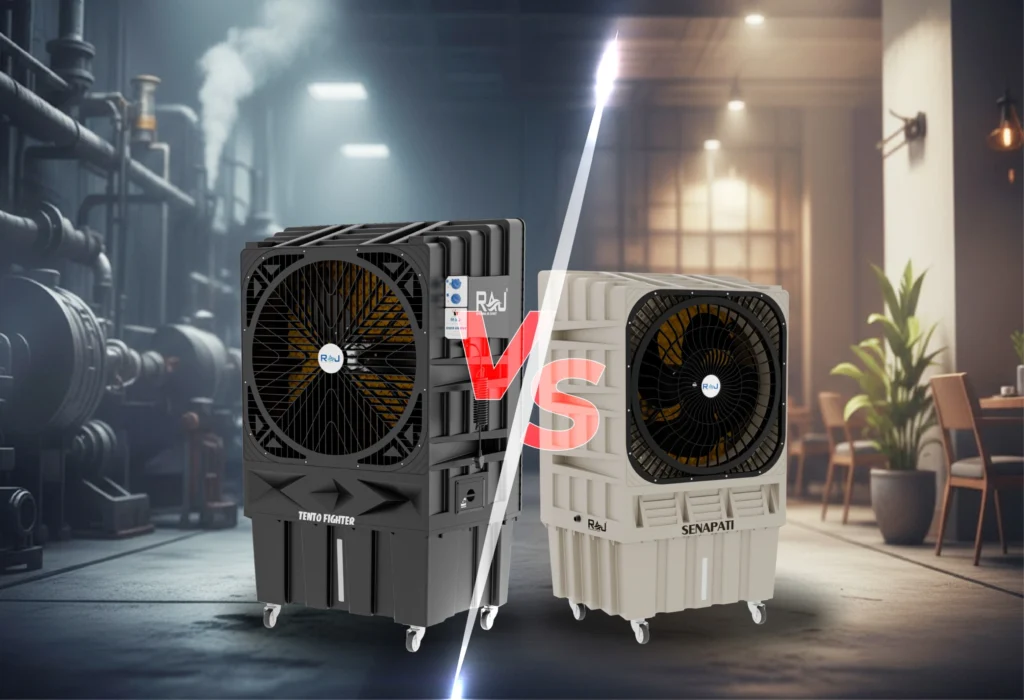Effective cooling is essential in both industrial and commercial spaces to maintain comfort, productivity, and efficiency. Whether it’s a bustling restaurant, a retail store, a large manufacturing plant, or a warehouse, maintaining controlled temperatures is crucial for employee well-being, protecting equipment, and ensuring customer satisfaction. Many business owners and facility managers often find themselves confused when deciding between industrial vs. commercial air coolers, as the terms are often used interchangeably. While both are designed to provide cooling, they are built for very different purposes and environments. Understanding the difference between industrial and commercial air coolers is key to choosing the right solution for your space and budget.
What is a Commercial Air Cooler?
A commercial air cooler is specifically designed for small to medium-sized spaces where localized cooling is needed. These coolers are commonly used in areas like restaurants, cafes, retail shops, showrooms, offices, gyms, classrooms, and small halls. They are compact in design, easy to install, and portable, making them a practical choice for businesses that require flexible and efficient cooling solutions.
Commercial air coolers deliver moderate cooling capacity, which is ideal for spaces where people gather or work in a controlled environment. They also consume less power compared to larger systems, which makes them budget-friendly and energy-efficient. Many modern commercial coolers come equipped with convenient features such as variable speed controls, water-level indicators, and even ice chambers to enhance the cooling experience. For businesses that prioritize comfort for their employees and customers without the need for heavy-duty cooling, commercial air coolers offer an effective and affordable option.=
What is an Industrial Air Cooler?
An industrial air cooler, on the other hand, is built for heavy-duty and large-scale cooling needs. These coolers are designed to handle environments such as factories, warehouses, production plants, construction sites, and other spaces that generate significant heat from machinery, large workforces, and long hours of operation. Unlike commercial coolers, industrial coolers are engineered with robust, durable materials that can withstand harsh industrial conditions and continuous usage.
Industrial coolers have a much higher cooling capacity and are capable of pushing out massive volumes of air to cover large areas efficiently. They are typically installed permanently in fixed locations, such as rooftop or duct-mounted systems, and are designed to deliver consistent cooling over wide spaces. Even though they have higher power requirements, industrial coolers are energy-efficient for large spaces because they reduce the overall cooling cost compared to running multiple smaller units or traditional air conditioning systems. Their purpose is not just to cool the environment for comfort but also to maintain safe operating temperatures for machinery and to protect productivity levels in demanding work settings.
Key Differences Between Industrial and Commercial Coolers
The differences between industrial and commercial air coolers become clear when considering factors like size, capacity, airflow, durability, and power consumption. Commercial coolers are smaller and portable, designed for localized cooling in areas such as restaurants, offices, and gyms. Their moderate airflow is ideal for cooling single rooms or smaller spaces, making them a convenient and cost-effective choice for businesses that don’t require large-scale cooling. Industrial coolers, on the other hand, are significantly larger and heavier. They are built to provide high airflow, covering vast areas like warehouses, factories, and production floors.
In terms of durability, commercial coolers are constructed with lightweight materials suitable for indoor environments, whereas industrial coolers are made with heavy-duty, corrosion-resistant materials to withstand continuous operation and harsh conditions. When it comes to energy use, commercial coolers consume less power due to their smaller size and limited output. Industrial coolers, although higher in wattage, are more energy-efficient for large operations as they eliminate the need for multiple smaller units or energy-intensive AC systems.
The difference in application is equally important. Commercial coolers are ideal for customer-facing businesses and smaller spaces, while industrial coolers are a necessity for large-scale operations where maintaining a cool environment directly impacts productivity and safety.
Comparison Table: Industrial vs. Commercial Coolers
| Feature | Commercial Air Cooler | Industrial Air Cooler |
|---|---|---|
| Size | Compact, portable | Large, fixed or duct-mounted |
| Cooling Capacity | Moderate – for small/medium spaces | High – for large-scale areas |
| Airflow | Moderate | Very high for wide coverage |
| Durability | Lightweight materials | Heavy-duty, corrosion-resistant |
| Power Consumption | Low | Higher, but efficient for large spaces |
| Best Suited For | Shops, offices, cafes, gyms | Factories, warehouses, plants |
| Cost | Lower initial investment | Higher initial investment, long-term savings |
Which One Should You Choose?
Deciding between an industrial and commercial air cooler largely depends on the size of your space, the nature of your operations, and your budget. For small to medium-sized businesses like restaurants, retail stores, gyms, and offices, a commercial cooler is usually the ideal choice. It provides sufficient cooling for comfort, is affordable to install, and is easy to maintain. These coolers are perfect for businesses that focus on enhancing customer experience and creating a pleasant environment for employees.
For large-scale operations such as factories, warehouses, and manufacturing units, an industrial air cooler is essential. These coolers are capable of handling heavy heat loads, operating continuously, and covering vast spaces effectively. While they require a higher initial investment, they provide long-term value by ensuring consistent cooling and protecting machinery and workers in demanding environments.
Cost and Maintenance Considerations
Cost and maintenance are important factors when comparing industrial and commercial coolers. Commercial coolers have a lower initial cost, making them an attractive option for smaller businesses. Their maintenance is also straightforward, usually involving regular water refills, cleaning of cooling pads, and periodic servicing. Industrial coolers, on the other hand, require a higher upfront investment due to their size, durability, and advanced features. Maintenance for industrial coolers is more structured, involving scheduled cleaning of ducts, water systems, and pads to ensure continuous and efficient operation.
In terms of long-term efficiency, industrial coolers prove to be more cost-effective for large-scale operations. While they consume more power, they can cool vast areas with less energy compared to running multiple smaller commercial coolers or using air conditioning systems, ultimately reducing the overall cost of cooling.
Conclusion
Choosing the right air cooler ultimately depends on understanding your specific cooling needs and the size of your space. Commercial air coolers are best suited for small to medium businesses where customer comfort and employee well-being are the top priorities. They are affordable, portable, and easy to maintain, making them a practical choice for localized cooling. Industrial air coolers, on the other hand, are designed for heavy-duty operations, delivering powerful and continuous cooling for factories, warehouses, and other large-scale facilities where productivity and safety rely on temperature control.
By carefully evaluating factors like coverage area, durability, energy efficiency, and cost, you can make an informed decision and invest in a cooling solution that supports your business growth while keeping operational costs under control.

